new posts in all blogs
Viewing Blog: The Fourth Musketeer, Most Recent at Top
Results 51 - 75 of 435

reviews and more about historical fiction for children and teens
Statistics for The Fourth Musketeer
Number of Readers that added this blog to their MyJacketFlap: 2
Recommended for all ages.
In my new job as a children's librarian I am fortunate to have many new picture books cross my desk each week. While there are many that I like, there are few that I fall head over heels in love with. One of the few that has captured my heart recently is One Gorilla: a Counting Book, a new release by Anthony Browne for Candlewick Press.
Anthony Browne has long been a favorite of mine; the internationally renowned author and illustrator is a former British Children's Laureate and is especially known for books about monkeys and primates, among my favorite animals. But I don't hesitate to say that this new release is his most striking book ever. Indeed, this is one of the most stunning picture books I've seen this year. It's an oversized picture book, with brightly colored paintings of our primate cousins, including the well-known (gorillas, chimps, orangutans) and the lesser known (macaques, colobus monkeys). Browne's artwork is at once highly realistic and almost photographic and also fanciful, with a palette that exaggerates nature's colors. All of the primates are looking directly at the viewer or reader, connecting with us in an extraordinary way. The book ends by explaining that all these animals are primates..."all one family. All my family....and yours!" The book ends with a double page spread of humans from all different cultures, all colors and nationalities, stressing our commonality with our primate cousins. Below is an example of the gorgeous two-page spreads from this book. Don't miss it!
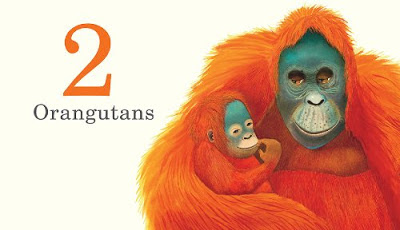
Recommended for ages 5-12.
What was life like for ordinary American Indian children growing up on the American plains? In this handsome new volume from independent publisher Wisdom Tales, editor Michael Oren Fitzgerald pairs quotations from Indian chiefs and elders who lived in the days before native people were forced onto reservations with rare sepia-toned photographs to conjure up a nomadic way of life that vanished long ago.
The book does not unfold in traditional narrative non-fiction style; instead the editor has compiled two page spreads complete with quotations, antique photos as well as modern photos of artifacts of Indian life. He covers a wide array of different topics relevant to children's lives. These include: mothers, play, story-telling, daily camp life, horses, great chiefs, and more.
Because there is no narrative from the editor as part of the text, the quotations and photographs together evoke a nostalgic view of the American Indian experience on the Plains. The editor emphasizes the native people's spiritual connections to the land as well as lighter topics. The book ends with beautiful color photographs of modern American Indian children at festivals, dressed in traditional garb, with the headline "But many traditions live on..."
An endnote provides more information about editor Michael Oren Fitzgerald, and a bibliography of his books for children and young adults. I would have liked to see appropriate websites and books by other authors offered as resources as well.
With the implementation of the Common Core, there is an increased need for excellent nonfiction books for young people.
Children of the Tipi would certainly make a strong addition to classroom and library collections about American Indian culture, but it's also a volume that parents would enjoy sharing with their children at home.
Note: Review copy provided by publisher.
For ages 6-12.
In this picture book for older readers, the author remembers growing up in the American midwest, in rural Indiana, at a time when there were few other Chinese families around. When she sees her Chinese cousins in Chicago, they have Chinese lessons, time to play, and lots of dumplings. While driving from Indiana to Chicago, they discover a farmer growing soybeans, a food they dearly missed from China. They are thrilled and a tradition is born. They pick soybeans from the befuddled farmer (at the time soybeans were grown only for pig feed) and take them home for their family's first soybean picnic. Over the years, the soybean picnic becomes an annual affair, with more and more Chinese families invited to share the treat. Soon the event grew so big it had to be held at a city park. An author and illustrator's note tells more about the author's family, and the tradition of the soybean picnic. The narrative is illustrated with charming paintings done on handmade porcelain plates, which were then fired. A heartwarming story about immigrant families adapting their culture in a new country.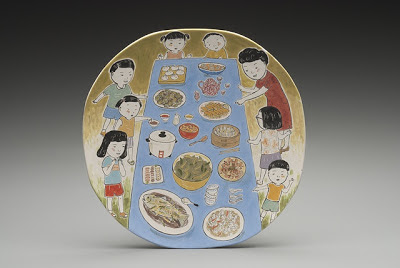 |
| One of the ceramic plate illustrations |
Recommended for all ages
With Mandela apparently on his deathbed, it's an appropriate time to take a look at this moving new picture book biography of the iconic South African figure by celebrated African-American author/illustrator Kadir Nelson. Nelson's magnificent paintings complement the poetic text, which begins by evoking Mandela's bucolic boyhood in the South African bush. At the tender age of 9, he was sent away to continue his schooling, the only one in his family to be chosen for Western formal schooling. His intellect was apparent even at an early age, and we see Nelson (a name given to him by British teachers) growing into a fine young man, a lawyer for those who couldn't defend themselves. Kadir Nelson describes the cruel policies of apartheid in simple terms suitable to a young audience, in a lyrical text that resembles free verse. The outlines of Mandela's life are all here--Mandela protesting with his fist raised in the air, Mandela tried and imprisoned, his people fighting for his release over the long years of jail, his triumphant return and election to president. But as usual with Kadir Nelson's work, it is the illustrations which overwhelm us with their quiet power. Highly recommended for adults as well as children.
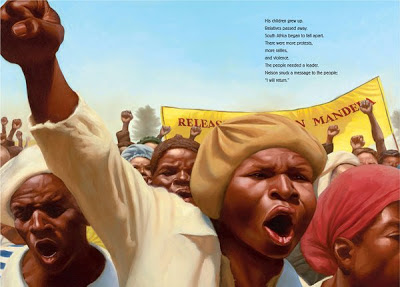
For more on Mandela for young people, check out his own picture book autobiography, Nelson Mandela: Long Walk to Freedom (Flash Point, 2009). For older children and adults, I would also recommend the abridged version of Mandela's own autobiography, Mandela: An Illustrated Autobiography (Little Brown, 1996), a fascinating and accessible version of his much longer autobiography published in 1994.
Recommended for ages 4 and up.Picture books about dogs are a dime a dozen, but picture books about dogs in Paris--ooh, la, la, that's a smaller group. I remember on my first trip to Paris, many many years ago, being flabbergasted that dogs were everywhere--including in restaurants, where they were treated with great respect. But what would it be like to be an American dog in Paris?
In
Paris-Chien (a pun on the French word
parisien--OK, it took me a few minutes to get that one, and you have to pronounce Paris in French--
par-ee--for it to work!), we meet Hudson, an adorable Norwich terrier who has recently moved to Paris with his American owner. However, adjusting to a new culture is apparently as difficult for dogs as for people--Hudson didn't realize that French dogs spoke French rather than "dog"! But no worries, his owner enrolls him in French language classes, taught by Madame Vera--a French poodle. Soon Hudson is as happy as a clam--or maybe a baguette or croissant--in his new home, and even has a French girlfriend!
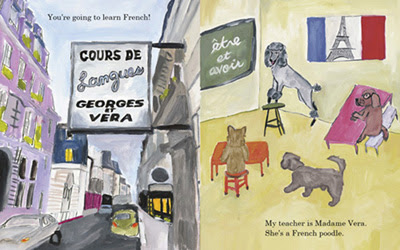
This is a delightful book that is sure to please dog lovers and Francophiles alike. The book is peppered with French phrases, which are translated in a "petit dictionnaire" in the back (although there is no phonetic translation, so the author seems to assume that the readers will already know a little French). Children and adults alike will enjoy the "fish out of water" story of Hudson adjusting to Paris, told with a gentle sense of humor. The gouache artwork is particularly charming, and the color palette and flat, stylized technique evoke 20th century French artists such as Matisse.
Author Jackie Clark Mancuso was inspired to write this book by her own experiences as an ex-pat in Paris. Hudson is a real dog, and you can learn more about him on his
Facebook page.
Recommended for ages 5 and up.I am not much of a sports fan, but I do enjoy books about baseball players of long ago. Babe Ruth is such an epic figure in the history of sports, but one that I suspect kids today do not know that well. When I was growing up, I remember well when Hank Aaron broke Babe Ruth's lifetime home run record, which was a huge deal back in 1974. Of course since then, the record has been broken again by the controversial Barry Bonds, and now Ruth ranks 3rd on the home run king list. But given the much shorter seasons played in those days, being third doesn't really diminish Ruth's stature as one of the great home run kings!
Matt Tavares has written some wonderful baseball picture books, including
Hank Aaron's Dream and T
here Goes Ted Williams.
Tavares' new picture book on Ruth is a wonderful addition to these prior books. It concentrates on Ruth's early years, when he was just a kid in Baltimore who got into trouble a lot. At the tender age of seven, he was left by his parents at a very strict reform school, St. Mary's Industrial School for Boys. Although to contemporary kids this must seem like a fate worse than death, it's not so bad for George, because he gets to play baseball almost every day. At school, he's taken under the wing of Brother Matthias, an excellent baseball player himself. While still at St. Mary's, George is signed by the minor league Baltimore Orioles. His teammates nickname him "Babe" since he is only sixteen and amazed by everything outside the gate of St. Mary's! Starting out as a pitcher, Ruth is quickly traded to the major leagues, where he becomes a star pitcher for the Red Sox--at least until 1920, when he is sold to the Yankees for the huge sum of $125,000--the biggest fee ever paid at that time for a baseball player!
But Tavares shows us another side of Ruth--his compassion for orphans and kids from the wrong side of the tracks. When his boyhood home, St. Mary's is destroyed by fire, Ruth invites the school band to tour with the Yankees to raise money to rebuild the school. He even invites them to ride the train with him and treats them to ice cream sundaes in the dining car!
Tavares' oversized illustrations capture the jumbo personality of Babe Ruth, who became the biggest celebrity in America. Tavares writes "He wears fancy clothes, custom tailored just for him. He drives fast cars and throws wild parties. He eats enormous amounts of food. He does whatever he wants. And he clobbers the baseball like nobody ever has."
Back matter includes an author's note with additional biographical information on Ruth, as well as his pitching and hitting stats and a brief bibliography. Highly recommended!
I am delighted to be a stop on the blog tour for author Jennifer Angus, debut author of a delightful and innovative historical fantasy for middle grade readers, In Search of Goliathus Hercules. Set in 1890, this novel features an appealing young hero, ten-year old Henri, who discovers an incredible talent--he can communicate with insects! This ability allows him to train an amazing flea circus and communicate with ordinary houseflies and butterflies. But there is more afoot--with shades of Kafka, Henri discovers he is becoming more insect-like by the day! And can he solve the mystery of his father's disappearance into a far-off jungle, never to be heard from again?
Her novel definitely channels the wry humor of British authors Roald Dahl and Eva Ibbotson and features the most charming insect characters I have encountered since James and the Giant Peach. It's a real treat to read, with a quirky sense of humor and many endearing characters.
In this guest post, I asked her if she would reflect on her lifetime interest in insects.
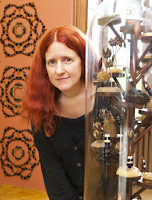 |
| Jennifer Angus |
Perhaps you have walked on a warm summer evening and seen fireflies dancing in the sky. There is something magical about the sight. I’ve often wished I could be part of the festivities and the mystery. That desire might seem childish which brings up an observation that children’s literature is populated with wonderful six legged characters such as the insect companions in James and the Giant Peach or the fabulously glamorous cockroach in La Cuchuracha Martina. I was interested to discover that what is considered the first children’s story in the English language which was not a moral tale or fable is The Butterflies Ball and The Grasshoppers Feast by William Roscoe dating from 1808. In the Victorian era, both adults and children were introduced to the natural world through a large number of educational publications in which insects were anthropomorphized so as to have greater appeal to the general reading public. Voracious collecting of all manner of plant and wildlife was extremely popular at that time.
Through second to fifth grade my family lived in Niagara Falls, Canada. On a rainy Saturday or Sunday my parents would give my brother and me money to go to a museum. Our favorites were the Ripley’s Believe It or Not, the Houdini Wax Museum and the Niagara Falls Museum. The latter was an old Victorian style museum that was old, musty and near the end not even heated. On the top floor were the animal “oddities” – things like the 2-headed dog or the five-legged calf. On that floor I remember seeing insect collections that were put into words and patterns. These early experiences have very much informed both my art exhibitions and my writing.
I am best known for my “insect wallpapers” but as my thinking as progressed I have made my own cabinets of curiosity in which Victorian poems are etched on to the backs of metallic beetles, and shadow boxes containing insect samplers that spell out nursery rhymes. For my exhibition “Insecta Fantasia” at the Newark Museum I created dioramas in which insects appear to enact scenes from famous fairytales such as Sleeping Beauty and Hansel and Gretel.
Typically a diorama creates a realistic scene however in mine the insects inhabited a monochromatic brown world of beeswax. The subdued landscape is both surreal and provocative. The dioramas inspired further works in which vintage style dollhouses were covered in wax along with the furniture too. Again insects appear to live and carry out activities in these spaces. The houses with their 6-legged occupants are reminiscent of the work of Walter Potter (1835-1918), the celebrated taxidermist whose Kitten Wedding included 20 felines taxidermied and dressed for the occasion. The Rabbit School saw 48 bunnies posed at desks and studiously note taking upon slates.
Likewise in children’s literature animals are often anthropomorphized so that the reader can relate thus giving both insight and empathy. Author Beatrix Potter turned the tables so that despite the fact that Peter Rabbit naughtily gorged himself on Farmer McGregor’s crops the reader cheers for Peter rather than the aggrieved farmer. In the “Tale of Two Bad Mice,” the aforementioned rodents create mayhem and destruction in a dollhouse yet all is forgiven when they offer restitution of sixpence and a daily cleaning service.
Similarly I seek to rehabilitate the image of insects through my artwork and “In Search of Goliathus Hercules”.
Giveaway: Albert Whitman & Co. has kindly made available a give-away for The Fourth Musketeer blog readers. If you would like to win a copy of this unique novel, please leave a comment below with your e-mail address! The winner will be chosen by June 15th through a random number generator.
Recommended for ages 10 and up.I'm fascinated by the character of Tyrion Lannister, the cunning dwarf in
Game of Thrones. You don't find a lot of literature with a dwarf as one of the heroes (or perhaps in Tyrion's case, an anti-hero). Perhaps my interest in Tyrion is why I picked up this book by
Katherine Marsh about a teen-aged dwarf in 16th century Europe, but Jepp's story quickly engaged me on its own terms.
Jepp is living a relatively happy and protected life at his mother's inn in the countryside, until a wealthy courtier appears and invites him to a life of luxury Coudenberg Palace, the home of the Spanish Infanta. There he joins a small group of court dwarves, and Jepp is shocked when he realizes that he is to be a pampered pet, fed morsels at the dinner table and popping out of pies. Jepp plots a daring escape for himself and his dwarf friend, Lia, but is soon recaptured and sent away to another court, that of a Danish nobleman, Tycho Brahe. His new master is fascinated by the science of the stars, including astrology. Despite his dwarf size, Jepp is no fool, and would like to be part of the learned world of the scholars. Can Jepp change his own destiny or is he fated to always be controlled by others? How will he find his way in what often is a cruel world?
The author states that she was inspired to write this novel through her fascination with the famous paintings of court dwarfs by Spanish painter Diego Velasquez. As she explains in an author's note, Jepp was an actual dwarf who served as court jester at the court of Tycho Brahe, but very little is known about him. Although his story is largely invented, the life of court dwarfs was carefully researched by the author and seems to be accurately portrayed. Marsh was also inspired by her mother's passion for astrology, which plays a central role in this story.
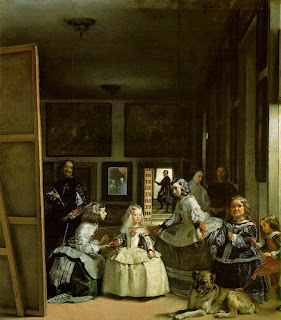 |
| Las Meninas, by Velasquez |
If you're tired of dystopian and fantasy YA novels, I highly recommend this book! Marsh's book was honored as a
New York Times Notable Children's Book of 2012 and also by
The Wall Street Journal's Best Children's Books of 2012. It definitely stands out among the crowd of books that all seem to look the same these days. Even the handsome cover and design of this book are unique, with the end papers decorated with a beautiful astronomical chart that depicts, instead of constellations, various elements of the story. It's a unique coming of age story, with a beautifully rendered and written story, which transports us to another time and place in the way which good historical fiction can do just as well as fantasy. Being a YA novel, there's even a bit of romance involved.
In addition to the above-mentioned Author's Note, back matter includes an interview with the author.
Recommended for ages 12 and up.
"Some kids got Disney. I got Hitler." No way could I NOT read this book after reading that line on the back cover--and the title intrigued me as well.
The novel's protagonist, Lauren, doesn't want to be Jewish any more. It's not that she wants to be a different religion--she just wants to be a "non-Jew by choice." She grew up going to Jewish day school; her father's a Holocaust historian. At her house, she quips, every day was Holocaust Remembrance Day. Family vacations (instead of going to Disney World like other people) revolved around trips to Holocaust memorials. "Why would anyone want to belong to a religion that was all about loss, grief, and persecution?" she muses.
Lauren manages to convince her parents to send her to the public high school. But even there--where incidentally they have a much better basketball team for Lauren to play on--she can't escape the legacy of the Holocaust, however much she might try. When she sees some of her friends--including Jesse, a boy she likes--playing Nazi war games, she is confronted with a dilemma. Should she betray her friends, and risk being a social pariah at school, or betray her heritage, by remaining silent?
While in many ways this is a "typical" teen novel with boyfriend and friendship drama, Lauren's struggle with her heritage is described in an entertaining and also thought-provoking way that make the novel highly readable for teens. Jewish young people are likely to be particularly attracted to this novel, particularly because of the intriguing title!
Recommended for ages 9-14.
Given the complexity of the topic, it's perhaps not surprising that there's not a plethora of novels for young people on the Israeli-Palistinian conflict. It's a topic that ignites fires of passion on both sides, and what a challenge for a novelist to try to present a balanced point of view in a book for young people.
I was very impressed with
Sharon McKay's take on this topic. She presents us with two teenaged boys, one Jewish Israeli and one Palestinian, who are thrown together as roommates in a Hadassah hospital in Jerusalem. Both have suffered grievous injuries; Sam, our Israeli teen, has a seriously injured leg and may face amputation, and Yusef, our Palestinian, has lost an eye and may lose his other eye as well. Both have their own extreme prejudices, indeed, we could say hatred, of the other side. But when they decide to escape from the hospital to go on an innocent errand--a trip to a famous candy shop in Old Jerusalem, they get lost and are quickly in more trouble--and danger--than they could have imagined. Can they work together to find their way back?
McKay does an admirable job of using Yusef and Sam as spokespeople for each side of the conflict, and we see through these two boys the misperceptions and fear each side has of the other. Their frustration with the other's point of view even makes them come to blows at one point in the novel. McKay takes no particular point of view, but tries to show the commonalities between the two groups as well as the differences. While the "happy" ending may be a bit pat, I would recommend this novel to young people who want to get a better understanding of the emotions behind the long-ranging Middle East conflict. Back matter includes notes which define certain terms which are used in the novel.
This novel has received numerous awards, including the 2013 Helen and Stan Vine Canadian Jewish Book Award.
Recommended for ages 10-14.
Release date: May 28, 2013
In recent years, with the great attention paid to the problem of bullying both in schools and on-line, many new children's novels have come out dealing with this topic. Mark Goldblatt's Twerp is a worthy addition to any library looking for books addressing this subject.
Julian Twerski (aka Twerp) doesn't think of himself as a bully. But after he's suspended for his involvement in a bullying incident, his English teacher asks him to keep a journal, hoping he'll open up on paper about what really happened (and also giving a framework for this book). Julian sees the journal as a great way to get out of writing a paper on Shakespeare's Julius Caesar, since he HATES Shakespeare with a passion. The journal turns into a diary of Julian's sixth grade life in 1969 Queens, in which he examines his friendships with neighborhood boys, has crushes on girls, worries about whether he's still the fastest kid in the 6th grade, and muses on all the terrible things he's ever done--all except what happened to Danley Dimmel, the victim of his bullying that's at the root of the journal--and the novel. There's plenty of comedy in this story, including a subplot where Julian writes a love letter for his tongue-tied best friend (shades of Cyrano de Bergerac) with predictably disastrous and hilarious results. But there's also a serious thread, with the book's examination of bullying, why it happens and what Julian does to try to deal with his guilt over the situation.
Author Goldblatt describes himself on his website as a "theologian, novelist, columnist and book reviewer as well as a professor at Fashion Institute of Technology of the State University of New York." This is his first novel for young people, and was inspired by his own childhood growing up in Queens. The author's authentic middle-school voice reminded me of Gary Schmidt's The Wednesday Wars novel, which takes place around the same time.
Twerp is well worth reading, particularly for middle school aged kids. Although the novel is set in 1969, Julian and his friends are definitely characters that young readers will identify with, and the story could just as easily take place now (except there's an absence of cell phones, texting, computers, and other high-tech facets of modern life).
Recommended for ages 8-12.Dear America is a go-to for historical fiction for young people, and the series keeps expanding with more titles by award-winning authors. One of the newest entries is by
Judy Blundell, author of award-winning YA novel
What I Saw and How I Lied, among others. In this novel, she presents the diary of a 14-year old Philadelphia girl, Minnie Bonner, the daughter of a French tavern owner who has deserted his wife and child. His wife sends her only daughter Minnie into service as a lady's maid for the young daughter of a rich family, the Sumps, who are moving to the great city of San Francisco.
As the reader can guess by the title, they arrive to a luxurious life in San Francisco just days before the earthquake strikes. Without giving away too much of the story, let's just say that in the immediate chaos after the great shock, Minnie finds herself confused for the Sumps' daughter, a great heiress, and confronted by moral dilemmas she never contemplated. As the disaster spreads into a firestorm that threatens the destroy the entire city of San Francisco, Minnie must decide who she is, who she wants to be, and what her destiny will be.
This is a real page turner for middle-grade readers. In the addition to the obvious excitement of the earthquake and its aftermath, Blundell adds a story of con men, political graft, and good and evil, personified by corrupt politicians and courageous firemen, among others. Although there is a female heroine, and this series is predominantly marketed to female readers, this novel, with its great sense of adventure, could easily appeal to boys as well. Highly recommended!
Recommended for ages 12 and up.This new Holocaust novel by author
Alan Gratz is based on the true story of Yanek Gruener, a Jewish boy living in Krakow whose comfortable, middle-class life is turned upside down when the Nazis take over his country in 1939. The title, of course, refers to the number tattooed by the Nazis on his arm at one of the ten concentration camps he managed to survive. In fact, survival at all cost is the theme of this gripping and moving novel, told in the first person by Yanek. From the opening line: "If only I had known what the next six lives of my life were going to be like, I would have eaten more," this is a story difficult to ignore.
When Hitler invades Poland, Yanek, like the rest of the Polish Jews, has no idea what is to come, despite having heard Hitler on the radio and his rhetoric about making Germany and the rest of Europe "Jew-free." He sees his neighborhood being walled off by the Nazis, with all the Jews who lived elsewhere in Krakow moving in. As things go from bad to worse in the ghetto, Yanek and his parents move into the pigeon coop on the roof, hoping that the location might help them avoid the "selections," when the Nazis took thousands of ghetto dwellers away at a time to distant camps--usually to their deaths. Wild rumors circulated about the camps--rumors that no one could believe. One day his parents, too, are grabbed in a deportation, and at 13 Yanek is on his own.
During the course of the novel, Yanek, too, is deported, and is sent to a series of ten concentration camps. First sent to
Płaszów, a camp run by the infamous SS Officer Amon Goeth (portrayed in the film
Schindler's List), he learns to be no one, and care for no one--the secret to survival in the camps. But can he survive with his human dignity intact?
Written in short chapters and sparse prose, the novel is filled with narrow escapes from death. Yanek manages to survive work details in salt mines and rock quarries, only to wind up at Auschwitz-Birkenau, where he survives the infamous showers and the deadly Death March from the camp at the end of the war. Like with other Holocaust stories, the reader is overwhelmed by the ability of the human spirit to survive under indescribably inhumane conditions, and likewise by the power that an individual's will to live can have.
An afterword tells more about Yanek Gruener, who took the name of Jack in America, and the author explains some of the liberties he took with time and events "to paint a fuller and more representative picture of the Holocaust as a whole." The author explains that these changes were made with Jack's permission to help ensure that "the horrors and realities of the Holocaust beyond those that he personally experienced would not be forgotten."
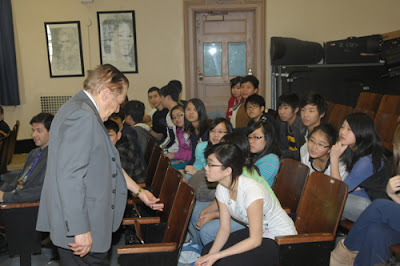 |
| Jack Gruener showing his concentration camp number to a school class |
I highly recommend this novel for any student learning about the Holocaust.
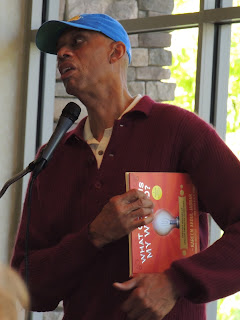 |
| Kareem Abdul Jabbar, April 2013 |
I was thrilled to have the opportunity several weeks ago to hear basketball great Kareem Abdul Jabbar speak at a library event about his books, in particular about his children's book,
What Color is My World: The Lost History of African American Inventors (co-written with Raymond Obstfeld). I grew up with a father who was a sports fanatic; in the absence of sons, he took his two daughters regularly to see the Lakers play at the Forum in Inglewood. I saw Kareem Abdul Jabbar play countless times (and his predecessor, Wilt Chamberlain) and have many fond memories of cheering for him and his teammates.
Walking into a room filled with library staff, he literally seemed to be double the size of most of the people in the room, and despite his reputation as being introverted, he seemed at ease speaking with his audience of librarians and library support staff. Wearing a UCLA Bruins cap (no Lakers garb in sight), he gave an inspirational talk about what inspired him to write two of his books:
What Color is My World, and
On the Shoulders of Giants, a book about the Harlem "Rens," an all-black basketball team from the segregated days of professional basketball. He bemoaned the fact that so many African American young people seem to think that the only avenue to success is to be Jay-Z or Kobe Bryant, and said he wrote
What Color is My World to help inspire young people to consider other careers. During a lively Q&A, he answered a variety of questions on his own role models in basketball (Bill Russell and Wilt Chamberlain), his fond memories of Coach John Wooden, his inspiration for writing, and more.
What Color is My World is an assortment of biographical sketches of famous and little-known black inventors, ranging from George Crum, inventor of the potato chip, to Dr. Charles Drew, who developed the concept of large scale blood banks. The biographical sketches are enveloped in a fictional story about twins who have moved into a new house and meet an old handyman who's coincidentally just full of knowledge about African-American history, particularly scientists and inventors. This scheme provides an engaging setting for telling the stories of these remarkable men (unfortunately, only one woman is included among those discussed). The design of the book is also noteworthy--it's abundantly illustrated with full-color illustrations and there are flaps which kids can open which discuss each of the scientists, giving a portrait and brief "fast facts". When the reader opens the flap, he or she will find more information about that particular inventor and his invention. Below are examples of several spreads from the book.
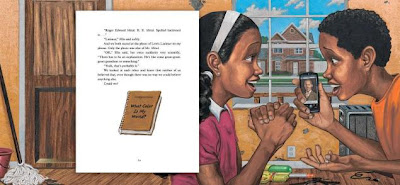
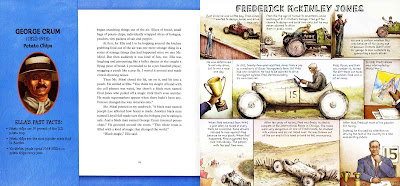
I would highly recommend this book to any young person interested in science and technology, regardless of his or her race. It's also a fun and entertaining book for parents to share with their kids.
Recommended for ages 8-12.
Award-winning author
Kimberly Newton Fusco really knows how to create strong female characters that stay with you long after you've finished her book. In her most recent book,
Beholding Bee, she weaves an especially magical and moving story that's perfect for middle-grade readers.
As the novel opens, we meet 11-year old Bee, who lives with a traveling carnival. It's 1942, and Bee's parents, carnival workers, were killed when she was four and she's been raised by a kindly young woman, Pauline. Bee fills her days chopping onions and helping at the carnival's hot dog cart. She has to deal with teasing about a prominent birthmark on her face, although her guardian Pauline suggests it's a precious diamond. In fact, the carnival owner only seems to be keeping Bee so that he can use her in his "freak show" when she's a little older. But when Bee's two best friends leave the carnival, Bee decides it's time to find a real home, and takes to the road with a stray dog as unwanted as she is and a small piglet.
Bee is taken in by two mysterious but kindly old women, Mrs. Swift and Mrs. Potter, who live in an old home that seems straight out of a fairy tale. Their clothes seem to come from another era, and curiously only Bee is able to see these women she calls her "aunts." For the first time, Bee goes to school, where she must cope with cruel bullying. Although she's put in a special education class where she clearly does not belong, at school she makes her first friend her own age. Gradually, Bee learns that there are people who care about her, and she learns to accept herself for who she is.
This is a lovely, lyrical, story filled with what Bookpage called "real magic"--"created by love and conjured up by need." Kimberly Newton Fusco manages to fuse magic and realism, love and cruelty, loneliness and hope into another novel that's a treasure for middle-grade readers (and adults who love to share books with children!)
I am so pleased to have a guest post today from author Annette LeBlanc Cate, whose book, Look Up! Birdwatching in Your Own Backyard has just been released by Candlewick. It's a delightful, whimsical introduction to birdwatching, and I asked Annette to comment on how to get our kids outside!Birdwatching with Kids--Can Birds Beat Lego Star Wars?I have been a little worried, as my book Look Up! comes out... that someone would ask me why I thought to write a book about bird-watching for kids, and that I wouldn't really have anything more profound and clever to say than..."I just wanted to, and I thought kids would like it, and I thought it would be fun".
That's it in a nutshell... but here... um... it is in a pumpkinshell...
Somewhere in middle of the 1990's I was the art director for an animated tv show, and although in some ways it was a deeply fun and happy time in my life... in others it was an excruciatingly horrible time in my life, fraught with soul-crushing deadlines, endless late nights staring into a computer screen til my eyeballs swam, drawing the same things over and over. Was I still an artist, if I did just draw these same cartoony characters over and over, and did that even matter? I worried that I was getting creatively bankrupt, and I also worried that I wasn't getting out of my dark basement much...i noticed that the only time I was outside was when i stumbled out to my car half asleep in the morning, and when I crawled back out to it, often late at night, and I thought, that can't be good for a person, especially someone who was supposed to be an artist.
I needed to get out, and get some air.
So I started walking at lunch, just to get outside, and, lucky for me, where I worked was right across the street from the Mt. Auburn Cemetery in Cambridge, Mass., which is a beautiful, famous old cemetery, filled with secret hidden dells and gardens. It's also filled with birds. I started to look forward to seeing them... so many I had never seen. Had they been here all along?
I also made a real effort to try and draw things that were not the characters in the show... I started keeping sketchbooks, just for drawing outside.... and it had to be outside, even if I was just sitting and drawing the skunk cabbage in the swampy stuff behind my house. If you sit still on the edge of a swamp and draw skunk cabbage... you know, pretty soon you're going to see some birds. And that is just what happened... soon I was watching birds, and then I was drawing them. And then I bought my first little field guide...a Peterson's beginner's guide, and that was it for me. Soon I was going out of my way to find places where birds would be, I was looking just for them.... in my spare time when I was out drawing, walking at lunch, and even looking into the sky and the woods when stopped at red lights during my sluggishly long commute to work. There really were birds out there, everywhere, and the more I looked, the more I saw them. I feel they saved me a little bit...they got me out of that dark computer filled basement, got me thinking of light and trees and everything else that was out there in the world....and they were waiting for me when the show ended, and I left that job, and had my first baby.
The bird book itself took years, and it grew out of the armloads of sketchbooks and notes. It grew from me reading field guides obsessively (is there any other way to properly read a field guide?) when I found I really needed to figure out what "breeding plumage" meant, because terms like that seemed to come up a lot. The more I cracked the code of field guides, figured out the secret language of birders, the deeper in I got, the more it all made sense, the more I loved it, the more I wanted to explain it.... because I guess I am just one of those people who likes to explain things. And I thought, really... a book about birds would be fun for kids.
Birding is sort of a natural thing for kids....they like to know the names of things, and they pay attention to stuff most grownups don't have the time of day for... like bugs on the steps, and butterflies, and flowers pushing up through the pavement.... and and birds, too. Kids start out loving to be outside, just running around and looking at things and poking around in the dirt.... being so interested in all those creatures that creep and crawl and slither and fly. So what happens?
Well, you know... life.... other kids...tv... video games.... soccer....that all happens. It creeps up. Your kids are no longer 5, now they see other kids with video games, and they decide they have to have Lego Star wars too, and who can blame them?. But can kids who love video games still love nature? Well... of course they can... but here's the catch... YOU have to love nature too, because that's how it works. We can, even with our older school-age children... influence (and by this i mean "make them") love what we love. So... if you want your kids to get out and love nature... well... you're going to have to get out there, too!
There are all sorts of ways to incorporate nature into your daily life... big ways, like, say, living in a house that abuts conservation land or spending vacations camping... and small ways... and I think the small ways are the best for starting any worthwhile endeavor. Nature is right outside the door... start by paying a little more attention, yourself. Maybe the next time you're sitting there after soccer practice you say to your kid... hey, why don't we just sit for a few minutes, nice just to sit, right? Is that a hawk up there on the lights? (and often, there really is one up there, have you ever noticed?) No need to hurry... because you're not in a hurry, right? Every grown-up knows there's always so much to do, so much to fit into the day... but maybe once in a while... you can just sit and look into the trees for a few minutes.
Maybe you start by saying, hey let's just take a little walk around the neighborhood after dinner, or even just sit on the steps in the evening, maybe we'll see some birds flying by... or we'll watch the chickadees at the feeder. Maybe you'll see some birds... and maybe you won't... but the important thing is that you are outside with a kid, just spending some quiet time... and not in a ticking-something-off-the-list way... but in a way that says "I really like just being out here with you in nature, it's nice to just be here." You have to be content, and not rushed, and not in a hurry. Kids know when you are in a hurry.. and I think birds do, too. So slow down, and just be. Outside.
And it doesn't hurt to buy a field guide and look up birds together, see what birds are native to your area... who lives in your yard? Going on a hike soon? Prepare first, say... hey, looks like we will be in the lair of the terrible Blue-winged Warbler, perhaps we'll see one! You might do a little homework yourself and make subtle suggestions about habitat and such... what birds might we see if we go to the mountains, or by a lake? Kids really are such clever and inquisitive creatures, just a few suggestions might be a good jumping-off point.... no need to make it a big learning thing (enough of that in school, I'm sure your kids will think) It's fun... and make sure you think it's fun, too.
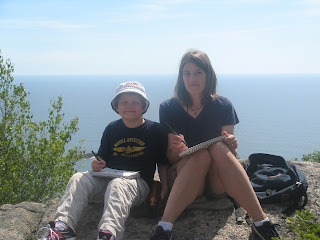 |
| Annette and son enjoying the great outdoors |
And maybe next time you'll say hey, look what I bought us, a sketchbook for you, and one for me, and these cool pencils, why don't we try a little nature drawing? And then you can draw horribly, and your kids will think that's funny, because they love when grownups do things horribly, and you can say yeah well the important thing is that i'm trying, and maybe you'll both have a good laugh and it will be a happy moment between two, or however many of you there are. I hope you see lots of birds... or that you have fun just looking and drawing, just being together out in nature.
Thanks so much, Annette, for your visit to The Fourth Musketeer!
Recommended for ages 6-12.
Release date: March 5, 2013In her debut book for children, author
Jan Pinborough offers a charming picture book biography of Anne Carroll Moore, an individual not well known among the general public but whose advocacy of library services for children are worthy of being celebrated in this handsome new volume released just in time for Women's History Month.
The book begins almost like a fairy tale: "Once in a big house in Limerick, Maine, there lived a little girl named Annie Carroll Moore. She had large gray eyes, seven older brothers, and ideas of her own." We soon learn that Annie is a bit of a rebel, not content to do what a girl was supposed to do in those days. She loved books, but in those days children weren't allowed in the library. When she grew up, she went to New York City on her own to enroll in library school, and soon went to work in a library where they had something brand new--a room just for children, where Annie even read aloud to them. An advocate for children, she later became head of the children's rooms at the New York Public Library's many branches. At this time, children weren't allowed to take books home, since the librarians thought the children wouldn't bring them back.
Pinborough portrays Anne Carroll Moore's feisty personality with a constant refrain in the book: "Miss Moore thought otherwise." When a grand new central library was built in the city of New York, Miss Moore was responsible for creating and designing the special place for children, complete with child-sized furniture. She brought authors, musicians and storytellers to entertain the children, and entertained them herself with her special doll Nicholas Knickerbocker and stories of his life. Even when she retired, she continued educating librarians across the country on how to create wonderful libraries for children.
Back matter includes more details about Miss Moore, the "trailblazing librarian," and a list of sources.
The lively artwork by
Debby Atwell, executed with brightly colored acrylics in a folk-art influenced style, is a wonderful match for Pinborough's breezy writing style. Every children's librarian will want to have a copy of Pinborough's tribute to this remarkable woman on his or her shelf. She was a true hero for librarians and children everywhere! Check out the
special website devoted to the book, an interview with the illustrator, Debby Atwell, at
Kidsbiographers Blog, and watch for a special post by Jan Pinborough on
Kidlit Celebrates Women's History Month on March 7!
Lisa Taylor of
Shelf-Employed and I are so proud to present the newest edition of our joint effort,
Kidlit Celebrates Women's History Month, beginning today! We are very excited with the roster of distinguished authors and bloggers who have joined in our efforts this year. For a complete list of contributors, check out the right sidebar on the blog. Some of the authors and books that will be featured include Jane Yolen and her new release,
Bad Girls, Jan Pinborough and her charming new picture book
Miss Moore Thought Otherwise, Tanya Lee Stone and her new book
Who Says Women Can't Be Doctors?, Renee Watson and
Harlem's Little Blackbird, and so many more. Some of the blogs whose authors will be contributing this year are
Read Roger,
Hope is the Word,
Bay Views and More,
the Reading Tub, and
Pink Me. This year's posts are sure to be as fascinating as in the past.
Here at the Fourth Musketeer, I will also be reviewing a number of new women's history related books this month, so look out for those as well.
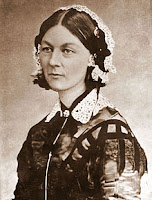 |
| Florence Nightingale |
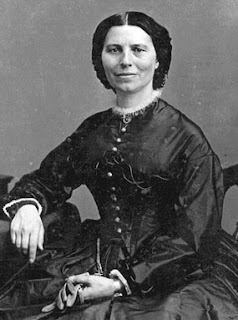 |
| Clara Barton |
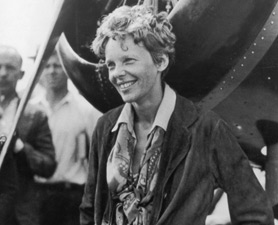 |
| Amelia Earhart |
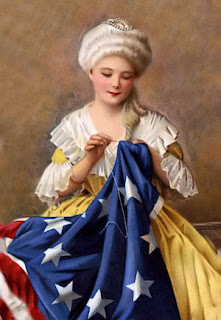 |
| Betsy Ross |
Since I grew up in an era when girls were lucky to find a biography of Amelia Earhart, Florence Nightingale, Clara Barton, and maybe Betsy Ross in the school library, I am overwhelmed by all the wonderful resources that are out there for today's girls. I am grateful to the many wonderful authors who not only write about the iconic figures of women's history, but also about the lesser-known women who are also outstanding role models for our girls of today. You, too, can learn about some of these terrific resources by following Kidlit Celebrates Women's History Month. And please pass on the word to others who might be interested, especially the gatekeepers who are often the ones who put books into the hands of kids: teachers, parents, and of course, librarians!
Recommended for ages 12 and up.The prostitute with the heart of gold is a popular trope in fiction--although not one that we see often in YA novels, particularly with their focus these days on the supernatural and the dystopian.
Ruta Sepetys, who won so many honors with her first novel,
Between Shades of Gray, (no connection with the even bigger best-seller,
Fifty Shades of Gray!) transports us to 1950 and the seedy world of New Orleans' brothels and gangsters in her new just-released novel,
Out of the Easy.
The book, narrated by the protagonist, 17-year old Josie, begins: "My mother's a prostitute. Not the filthy, streetwalking kind...But she sleeps with men for money or gifts, and according to the dictionary, that makes her a prostitute." Her mother works for Willie, based on an actual New Orleans madam of the time, and her on and off boyfriend is a nefarious gangster, Cincinnati. Josie hates Cincinnati and has a difficult relationship with her mother as well. Willie, the generous madam with the proverbial heart of gold but a tough exterior, takes on the role of mother-figure for Josie, while her own mother seems to have little patience for raising her. Josie's made good grades in school, and lives above a bookshop where she works part-time. She also works part-time cleaning the brothel. She's hoping to go away, leaving the Big Easy. Her heart is set on college--not in New Orleans, where everyone knows who she is--and who her mother is--but at Smith College, where she hopes to make a fresh start.
Josie's carefully made plans and all her savings might come to nothing when she becomes mixed up in the police investigation of a a murder of a handsome tourist--one who happened to come into the bookstore shortly before his death and who afterwards had drinks with her mother. As Josie becomes entangled in a web of lies, will she be able to escape her fate in New Orleans? Will she become just like her own mother in the end?
I found this new work by Sepetys to be engaging from the get-go; Josie is a strong, smart, character with lots of "moxie." Many of the more minor characters, especially her friend who is a closeted homosexual, are also appealing. Sepetys portrays the 1950's as a world of secrets, where everyone is part of the New Orleans Mardi Gras, wearing a mask that disguises who they really are. One aspect of the novel which did bother me is that the world of the prostitutes at the whorehouse seemed to be somewhat prettified; although Josie's mother is an extremely unlikeable character, the other girls at the house who play more minor roles seem to be more stereotyped. The gangsters, also, seem like stock characters. However, I enjoyed the fact that the story is not predictable, a fault I often find with teen novels.
This novel, despite its setting in the underworld of New Orleans, does not have gratuitous sex or violence, and could be read by middle school students as well as high school. While
Out of the Easy did not engage me emotionally in the same way that Sepetys' earlier novel,
Between Shades of Gray, did, it is a skillfully crafted novel that is well worth reading for its compelling main character and its well realized setting.
Recommended for ages 7-12.Candlewick has recently reissued in beautiful full-color paperback editions several biographies of famous African-American women by Kathryn Lasky. Earlier this month I reviewed
Vision of Beauty: The Story of Sarah Breedlove Walker. In
A Voice of Her Own, Lasky shares the story of an equally extraordinary woman, Phillis Wheatley, known as the first black woman poet in America.
Lasky begins her book as a young girl is kidnapped from Africa and sold into slavery in America in 1761. Through the girl's eyes, Lasky describes the harrowing journey from the west coast of Africa. A powerful illustration, painted in acrylics, shows a terrified young girl huddled in the hold of the ship. Upon arrival, she is purchased at a Boston slave market by the Wheatley family and given the name Phillis. When we next meet Phillis, we learn that she has become no ordinary slave. Mrs. Wheatley, realizing quickly how bright her new young slave was, decided to teach her to read and write, a sort of social experiment to see if an African could learn and understand the Bible. While this sort of instruction was not illegal as it was in the South, it was nevertheless never done.
Phillis proved to be such an able student that she progressed beyond English to Latin and Greek, geography and mathematics--this at a time when few white women were offered this sort of education, and only the elite among white men. Phillis was especially attracted to poetry, and had her first poem published when she was only fourteen years old. Phillis became a celebrity in Boston, and was trotted out by her mistress to all the finest houses in town as a sort of curiosity.
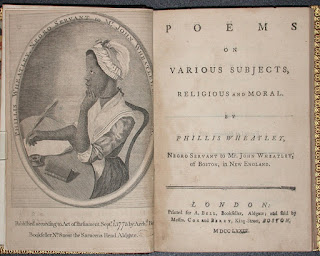 |
Phillis Wheatley. Poems on Various Subjects. London, 1783
|
Ironically, Boston printers refused to publish a compilation of Wheatley's poems, refusing to believe that a Negro slave could have written them, even after a panel of distinguished Bostonians, including John Hancock, interviewed her and vouched for her. Instead, the Wheatleys sent Phillis on a trip over the ocean to London, where she met a British publisher willing to publish her volume, and was received in the finest homes. Returning to America when she learned her mistress was ill, she continued to write, even as Boston rebelled against the British. After being published in London, her book sold well in Boston, and Phillis' fame grew. She was even invited to meet General Washington after writing a poem in his honor.
In an epilogue, Lasky relates briefly the last years of Wheatley's life; after receiving papers freeing her from slavery from the Wheatleys, she married and had three children, all of whom died in infancy. Her final poem, "Liberty and Peace," celebrated the end of the war, and she died in poverty at the age of thirty-one.
Back matter includes an index and a list of selected sources, as well as notes from the author and illustrator. The text includes a few brief quotations from Wheatley's poems.
At a brief 38 pages, with beautiful and abundant color illustrations, this very accessible biography is one step up from a picture book, and could be read aloud in class or by parents as well as read independently by students in about third grade and up. While the author provides plenty of information for a biographical report, the subject matter is fascinating and suitable for general reading as well as school assignments. Phillis Wheatley's remarkable rise from an illiterate slave to a literary figure celebrated on both sides of the Atlantic is an inspiration to share with children, particularly during Black History Month or Women's History Month.
I am delighted to welcome award-winning author
Deborah Hopkinson to my blog today, to discuss her newest historical fiction picture book,
Knit Your Bit: A World War I Story.
Q: How were you inspired to write a story about this little piece of history--the Knit Your Bit campaign for soldiers during WWI?
A: I am fascinated by stories of ordinary people in history, and also intrigued by historical photographs. Years ago I worked at the American Red Cross in Honolulu and learned about the home front efforts to knit for soldiers. That drew me to learn more about the social history of knitting in America and the result is Knit Your Bit!
Q: Are you a knitter yourself? Or perhaps a family member? If so, did that play a role in your inspiration for this story?
A: I actually do love to knit and I love yarn stores. But there is a big caveat to this – I am, quite honestly, not very good. I knit for relaxation only and I’m a bit like Mikey in the book – I keep dropping stitches! So I am content to knit scarves for myself – or for friends who can’t knit at all and so are a bit more forgiving of mistakes. I have a number of friends who are wonderfully accomplished knitters and the book is dedicated to them.
Q: Knit Your Bit tells the story of those at the home front during war. Do you hope that this book will be read by those children with moms and dads in Iraq, Afghanistan, and elsewhere? Will you be doing any special outreach to military families?
For more information about current Knit Your Bit projects check out:
Q: Please tell us a little bit about your research process for this book.
Q: I loved the illustrations by Steven Guarnaccia, which gave the story a real period feel. In fact, the illustrations reminded me of the TinTin comics. Can you comment about how the illustrations contribute to your text?
A: I absolutely agree! I love how Steven’s artwork complements the wonderful graphic style of the period. The Red Cross posters of the time were part of what drew me to the story, so when you add the historical photos on the endpapers along with the art and the poster in the note, it all seems to come together to give young readers both a sense that this did happen in a different time, but that some things remain the same.
Q: Please give us a brief preview of your upcoming book, The Great Trouble. And can you share with us some of the projects you have coming up?
A: The Great Trouble, A Mystery of London, the Blue Death, and a Boy Called Eel, is middle grade historical fiction about the 1854 cholera epidemic in London. I tried to give the story a Dickensian feel, while at the same time celebrate the pioneering public health work of Dr. John Snow, who was born 200 years ago, in 1813. I think kids will enjoy it. I am also working on projects about Beatrix Potter and World War II.
To find out more about my books I hope readers will visit me on the web at:
www.deborahhopkinson.com or look at my Pinterest boards at:
Thanks again to Deborah Hopkinson for appearing at The Fourth Musketeer. For other stops on her Knit Your Bit Blog Tour please check www.deborahhopkinson.com.
Recommended for ages 7 and up.
Get a jump on Women's History Month with this new picture book about Clara Lemlich, a remarkable 20th century labor leader. Its author, Michelle Markel, will be contributing a post to 2013's
Kidlit Celebrates Women's History Month, so don't forget to sign up to follow the blog so you don't miss any of the fascinating posts!
Picture books about early 20th century Jewish women labor leaders are not exactly published every day in the picture book universe, so I was especially eager to read this new work, illustrated by award-winning illustrator
Melissa Sweet, about Clara Lemlich, best known for organizing the shirtwaist makers' strike of 1909.
We first meet Clara as she is arriving in the United States, part of the mass of immigrants. But Clara is different--she's "got grit, and she's going to prove it. Look out, New York!"
Social justice is an overriding theme of this book, and we see through Clara's eyes the injustices of life in early 20th century America for the impoverished immigrants. "This was not the America she'd imagined." Girls are hired to make blouses for a few dollars a month, wages desperately needed to help support their families. Markel vividly describes the factories in just a few words--only two toilets, one sink, and three towels for 300 girls to share, and better not be a few minutes late or bleed on a piece of cloth if you've pricked your finger or you'll lose half a day's pay or even be fired.
But little Clara Lemlich is not one to sit back and take it. She organizes strikes, and despite being arrested repeatedly, and beaten, she is not easily silenced. But she realizes that a general strike of all the garment workers is what's needed to make the bosses stand up and take notice, and at a union meeting, she calls for women to launch the largest walk-out ever.
Clara is the leader of the Revolt of the Girls, as the newspapers call it. And eventually the owners meet some of their demands, including a shortened work week and better wages. Markel ends her elegie to Lemlich on a hopeful note, emphasizing how Clara's actions helped thousands of workers. "proving that in America, wrongs can be righted, warriors can wear skirts and blouses, and the bravest hearts may beat in girls only five feet tall."
An afterword provides further details about the history of the garment industry, and the role of Jewish immigrants in the business. Strangely enough, Clara is never identified as Jewish in the main text of the book, although she is shown shouting in Yiddish for a general strike. Back matter also includes a selected bibliography of general and primary sources. I would have also liked to have seen something on Clara Lemlich's later life. For example, she continued advocating for the oppressed her entire life, even helping to organize nursing home orderlies in the retirement home where she spent the end of her life.
 |
| Clara Lemlich |
Melissa Sweet's remarkable illustrations integrate the garment industry in a very literal fashion into her depiction of Clara's life. She uses watercolor, gouache, and mixed media, and pieces of fabric and sewing machine stitching are front and center in nearly every illustration. Some of the illustrations are particularly moving, including the one in which rows and rows of factory workers are shown from directly above, with the hundreds of girls appearing faceless and indistinct from each other like cogs in a wheel. I also loved the "girl power" illustration of Clara calling for a general strike--Sweet depicts Clara from behind, with hundreds of people in the audience raising their fists in solidarity and with her call for a strike in an oversized text balloon, with the word "Strayk!" (or strike!) in bright red lettering!
This is a must-have for anyone interested in exposing their children to important issues and people in the social justice movement, as well as outstanding women in history, those who chose to try to make a difference in an era when women were encouraged to make their dominion at home. To learn more about Clara Lemlich, consult Markel's bibliography or check out the entry in the
Jewish Women's archive on-line.
Recommended for ages 12 - adult.There is no shortage of stories about the Holocaust for young people, whether fiction or nonfiction.
Greenhorn, by author and children's book editor
Anna Oswanger, strikes a different chord than most of these works by focusing on the aftermath of the war, through the story of one of its young survivors.
Although published as a free-standing book,
Greenhorn, at 43 pages, is really more of an illustrated short story. Set in an Orthodox yeshiva in Brooklyn in 1946, the story tells of the arrival at the yeshiva of twenty orphaned Polish boys, including young Daniel, who won't let go of a little tin box he carries with him everywhere. Daniel rarely speaks, but Aaron, whose father is a rabbi, considers him his friend. Aaron stutters and is made fun of by the other boys, and feels some connection with the nearly silent refugee when the yeshiva boys start teasing Daniel about his box that he carries with him and even sleeps with. What's in the box, everyone wonders? The horrifying reality of what Daniel is carrying around contrasts with the innocence of the children at the yeshiva, who are concerned with baseball, basketball, candy, and other normal kid pursuits. We learn that inside the box is a greasy piece of soap, made with fat from the bodies of Jewish prisoners. Daniel clutches to it believing it could contain a piece of his mother, of whom he has not even a photograph.
An afterword explains that this story is based on a real incident in the life of Rabbi Rafael Grossman. A glossary provides explanations of Yiddish names, words and phrases used in the text.
Although this looks by the cover, the slight size of the story, and the abundant illustrations like a book for young children, I would not recommend this book for children younger than twelve. Also, some background knowledge of the Holocaust is useful for understanding the implications of the story. The story would make a good addition to a unit on the Holocaust, and could easily be read aloud in a classroom or read by individual students and used for classroom or home discussion. The Holocaust is such a vast tragedy that sometimes it is difficult to imagine the scope; this small book brings one element of a survivor's story vividly to life for young people.
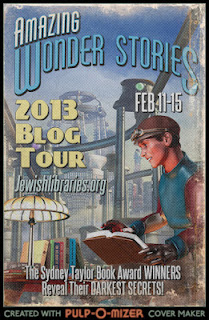.jpg)
I am so pleased to welcome to The Fourth Musketeer author
Deborah Heiligman, the winner of this year's Sydney Taylor Book Award for Teen Readers for her riveting teen novel,
Intentions. She has kindly responded to my interview questions below.
Q: Intentions tells the story of 15-year old Rachel, who in the beginning of the novel overhears her beloved rabbi committing adultery right in the sanctuary. The novel develops into a powerful and poignant story of betrayal and disappointment, and a coming-of-age story of learning to accept responsibility for our actions. It's your first YA novel. What inspired you to come up with this particular story? |
A: I wanted to capture that moment in a teen's life when she realizes that someone she adores and even idolizes is flawed. That happened to me in a pretty spectacular way in my community growing up (though not quite as spectacularly as in the book!) and it was a truly painful time. That moment informs who you become I think--because how you deal with it can shape the rest of your life. My editor Michelle described it as the moment when the black and white of childhood becomes the gray of adulthood. Even when we are adults we are walloped when someone we admire or love does something bad... to wit, I started writing this book during the Clinton/Lewinsky debacle. I liked Clinton a lot and I was upset by what he had done, and even more than that, I was sad that my young sons were confused and were asking so many questions. Yet because of that I knew I was on to something universal. Also around that time a rabbi in New Jersey was tried and convicted of having his wife killed. So it all came together in that way. It did, however, take me almost two decades to finish it in a way that I was satisfied with it and ready to throw it into the wide world. |
Q: Rachel has such an authentic-sounding teenage voice. Does she have anything in common with your teen self? How do you channel this teen voice in your writing?
 |
| Deborah Heiligman |
A: I think people who know me personally see some of me in Rachel, but she came to me pretty much fully formed as a character. There were certain things about her that felt too much like me, and so those I changed. In the end she became someone who I hope I would have been friends with at that age--but nice friends with! In terms channeling the teen voice, I find it very easy to access my teenage self, the emotions and desires, the gusts and squalls of those years. Perhaps I have not actually grown up....?!
Q: Rachel's personal disappointment with the rabbi changes her whole relationship with Judaism in this novel. Can you tell us a little about your Jewish background and the role Judaism plays in your life?
A: I grew up as what I affectionately call an Orthodox Reform Jew. My father was actually an immigrant from a shtetl in Lithuania, and grew up dirt-poor and Orthodox in Lehighton, PA. (They had to include Jews from the next town to have a minyan. I don't know how they kept kosher except that they had their own chickens.) He married my mom late in life (her second marriage) and she was kind of High Reform, though her first husband had been Conservative. SO. The agreement was that they would belong to the Reform synagogue, go every week, and always have a really nice Friday night dinner. So that's how I grew up. I loved my temple and I had lots of friends of all kinds, but my heart friends were mostly Jewish. As a teenager I got involved in Jewish youth groups and in college I went to Hillel (mostly to so a lot of cooking for a lot of people--challah for a hundred!, which was fun). In college I decided to concentrate (major) in religious studies. That gave my parents, especially my mother, kinipshun (spelling?) fits. She said to me on the phone when I told her: "There are two things you are not allowed to do: be a rabbi, or marry a rabbi." Wise woman, she. So of course for a whole week I was going to be a rabbi. Instead I became a writer! (My best friend became a rabbi and she and her rabbi husband read the manuscript for me a couple of times.) Back to real life: My husband agreed to bring up our kids Jewish (he is Jewish, but not religious) and so we did. We belonged to a great synagogue in New Hope, PA, that is Reconstructionist and both my sons became bar mitzvahs there. Since we moved back to NYC we don't belong to a synagogue. I miss it sometimes, but mostly I feel very happy and at home here, and we have holidays here and with my family back in Pennsylvania where I grew up.
Q: As an author, you have produced an extremely diverse group of books, ranging from fun rhyming picture books for preschoolers such as Fun Dog, Sun Dog, to the award-winning biography Charles and Emma and an upcoming picture book biography of mathematician Paul Erdos. What are some of your favorite parts of writing fiction as opposed to nonfiction?
A: You know in fiction you get to MAKE STUFF UP. I love that. But I also really love writing nonfiction. I must tell you that I always make stuff up, and usually tell my husband about it. He is a dyed-in-the-wool nonfiction writer so he doesn't quite get why when we're on a dark country road, for example, I might worry aloud about alien abduction or people by the side of the road who need our help but turn out to be shapeshifters, that kind of thing. When Intentions was accepted for publication, he said something like, "Oh good now I can tell myself you're a novelist, not crazy."
Q: You have said repeatedly that your all-time favorite children's book is Charlotte's Web (a favorite of mine as well--it's the first book I can remember asking for and reading myself). What are some of your favorite children's books with Jewish themes? And can you tell us some of the books that are currently on your nightstand?
A: Well at least I'm consistent. Wait, Charlotte wasn't Jewish? OK--some of my favorite books with Jewish themes (there are so many great ones!): The Treasure by Uri Shulevitz (one of my all-time favorite adult books is The Way of Man by Martin Buber, which has that tale in it as well); The Devil's Arithmetic by Jane Yolen; The Diary of Anne Frank; Cures for Heartbreak by Margo Rabb; Darkness over Denmark by Ellen Levine; Just Enough is Plenty by Barbara Diamond Goldin. (I wrote all those by memory, by the way--I think that's how you know your favorite books, when they just come to you POP! It means you are holding them in your heart always.)
Deborah, thanks so much for participating in the Sydney Taylor Blog Tour! Please check out some of the other blog tour stops listed below.
MONDAY, FEBRUARY 11, 2013Ann Redisch Stampler, author of The Wooden SwordSydney Taylor Honor Award winner in the Older Readers CategoryAt Shelf-Employed Carol Liddiment, illustrator of The Wooden SwordSydney Taylor Honor Award winner in the Older Readers CategoryAt Ann Koffsky’s Blog Doreen Rappaport, author of Beyond Courage: The Untold Story of Jewish Resistance During the HolocaustSydney Taylor Honor Award in the Teen Readers CategoryAt BildungsromanTUESDAY, FEBRUARY 12, 2013Linda Glaser, author of Hannah’s WaySydney Taylor Book Award winner in the Younger Readers CategoryAt This Messy Life Adam Gustavson, illustrator of Hannah’s WaySydney Taylor Book Award winner in the Younger ReadersCategoryAt Here in HP Louise Borden, author of His Name was Raoul WallenbergSydney Taylor Book Award winner in the Older Readers CategoryAt Randomly Reading WEDNESDAY, FEBRUARY 13, 2013Sheri Sinykin, author of Zayde Comes to LiveSydney Taylor Honor Award in the Younger Readers CategoryAt Read, Write, Repeat Kristina Swarner, illustrator of Zayde Comes to LiveSydney Taylor Honor Award in the Younger Readers CategoryAt Writing & IllustratingTHURSDAY, FEBRUARY 14, 2013Linda Leopold Strauss, author of The Elijah DoorSydney Taylor Honor Award in the Younger Readers CategoryAt Pen and Pros Alexi Natchev, illustrator of The Elijah DoorSydney Taylor Honor Award in the Younger Readers CategoryAt Madelyn Rosenberg’s Virtual Living Room FRIDAY, FEBRUARY 15, 2013Blog Tour Wrap-Up at The Whole Megillah
Recommended for ages 7-12.
Winston Churchill was known during his lifetime as the British Bulldog, due to his famous tenacity. In addition to being a great statesman, writer, and orator, Churchill was an animal lover, but it was not bulldogs who lived alongside the famous man, but miniature poodles.
This new picture book by debut author/illustrator
Kathryn Selbert tells the story of the British home front by highlighting Churchill's relationship with his poodle, Rufus. The author opens with the following:
"Rufus's best friend, Winston Churchill, is a busy man, but most days Rufus and Winston share a walk."
It's 1940, and Winston is managing a nation at war. Through the eyes of Rufus, Churchill's faithful brown miniature poodle, we see Churchill at work, visiting his secret underground bunker, the room from which he directs the war, going to the House of Commons, walking through streets filled with rubble from buildings destroyed by Nazi bombers. Rufus is not always invited along however; when Winston meets with his allies, Franklin Roosevelt and Joseph Stalin, to plan D-Day, Rufus sits by the door, patiently guarding the bunker. Rufus is once again by Churchill's side as the war ends, barking and howling with happiness. In the end, Rufus and Winston retire to the country, resting..."two war dogs." In the final lovely two-page spread dominated by the greens of the English countryside, Winston and Rufus gaze out to the horizon, with the country finally at peace.
Back matter includes a timeline of World War II, a look at Churchill and his affection for poodles (he owned two during his lifetime, both named Rufus), and a brief biography of Winston Churchill himself. The author also includes books for young Churchill fans, Churchill and World War II-related websites, a bibliography, and quotation sources.
Acrylic and collage illustrations have an nostalgic yet realistic look, with plenty of sepia tones suggesting a time long ago. Each two-page spread features a quotation by Churchill on a yellowed piece of paper, in an old-fashioned typewriter-style font, designed to look like it has been pinned to the rest of the picture. An interview on the
Charlesbridge website indicates that this book grew out of an undergraduate school project, but that the book originally focused more on the relationship between dog and owner, and less on the historical details. The book now provides more of an introduction to World War II, one that would be a good classroom read-aloud while studying that time period. The book will, of course, capture the heart of dog lovers as well as history lover, with its illustrations that depict Rufus in all his poodle splendor.
Disclaimer: I am a poodle owner and a poodle lover. Review copy provided by publisher.
 |
| Churchill with the real Rufus |
View Next 25 Posts

































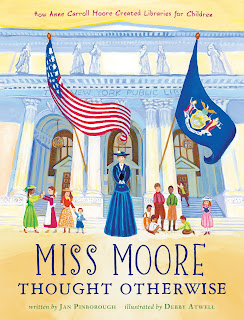
.jpg)







.jpg)



.jpg)



Wow, I'm so impressed with him! Who would have thunk he's write a book for kids, let alone one that's not on basketball?! Sharing it on Sulia!
Thank you for your post. This really is an amazing article and inspiring for so many others. I am honored to have been asked to post this story on my blog.
http://www.v3soft.com